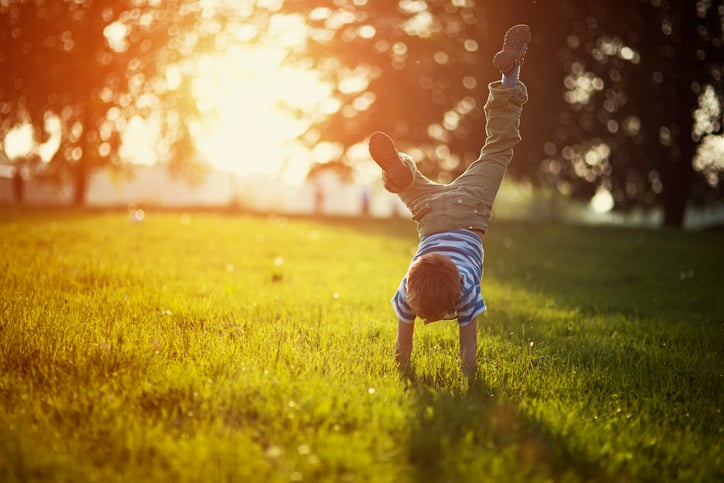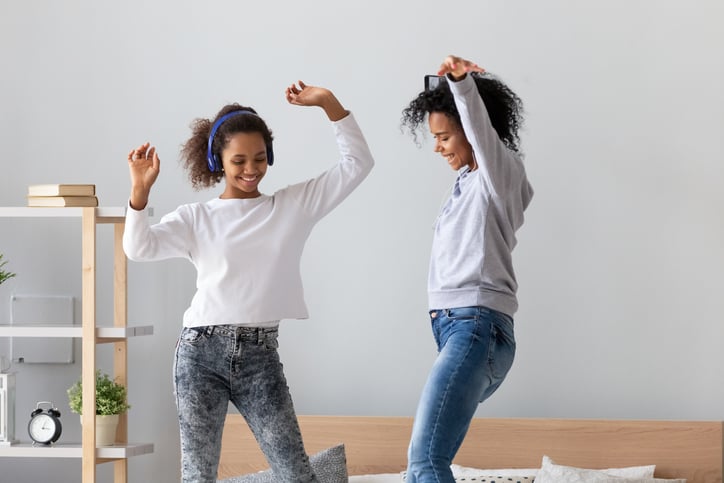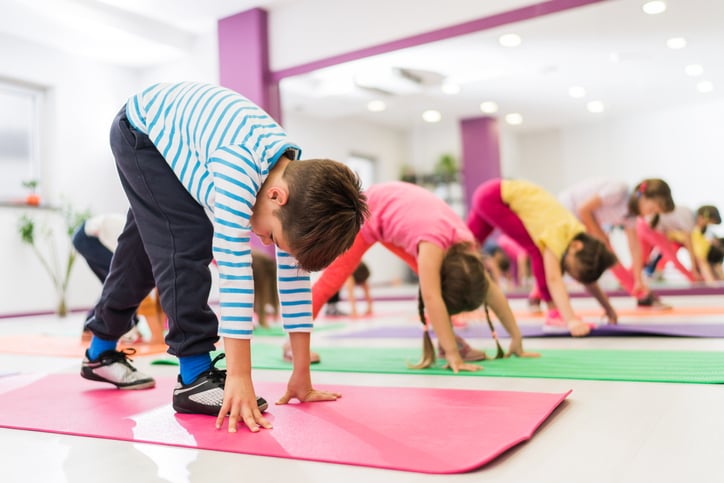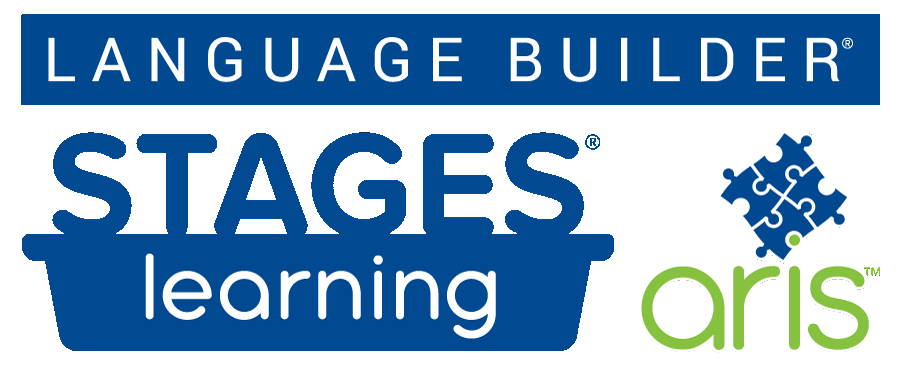
Adapting Activities for Your Autistic Child: Silent Disco Anyone?
Staying physically active has many health benefits, including improved mood, increased energy, memory, and cognition, better overall sleep quality, and a reduced risk of chronic diseases like asthma, stroke, high blood pressure, diabetes, obesity, depression, arthritis, anxiety, and metabolic syndrome.1 There are many ways to include fitness goals as part of a healthy lifestyle, and children on the autism spectrum also benefit from staying active.
The month of May has been dedicated to team sports and physical fitness. According to a speech given in the White House briefing room, it is important to incorporate physical activity on a regular basis as it leads to positive health outcomes and an improved sense of overall well-being.2 Engaging in any form of moderate physical activity on a daily basis has a positive effect on individuals in every stage of life and from all backgrounds–including those with autism.
Group activities and team sports are a unique way to keep children and adults active by providing healthy competition, social interaction, shared enjoyment, and even a boost of confidence.2 While honing skills on and off the field, athletic sports can enhance mental clarity and physical resiliency, improve focus skills, and build one’s ability to actively participate as a team member. While many activities are healthy for kids with autism, it can help to adapt some sports to make them more “friendly” for your child. As always, you know your child best, but here are some pointers for adapting activities and making choices about what physical activities you might consider introducing to your child.

Adapting Physical Activity for Individuals on the Autism Spectrum
Staying active is advantageous for everyone–and providing personal modifications can be helpful when supporting individuals on the autism spectrum. It is important to consider the needs of each person when implementing activities for physical fitness. Effective adaptations to physical activity can range from tweaking a portion of a game to make it more sensory-friendly to suggesting completely new ideas for remaining physically fit (such as developing new activities to play with peers while outside during recess).
Suggestions to consider when introducing physical activity and modifying fitness goals for those with autism3:
- Foster an approach that is fun, flexible, engaging, and stimulating for all students.
- Remember that individuals on the autism spectrum often thrive with consistency; consider establishing a set routine with structured daily activities.
- Provide clear and direct instructions; communicate in a way that the learner easily understands.
- Gather input from other individuals on the autism spectrum and ask students to share their preferences when developing fitness plans, creating schedules, and deciding which activities to incorporate on a regular basis.
- Include visuals like activity cards, live demonstrations of new exercises and activities, and video self-modeling examples.
- Try new combinations and different forms of physical activity (e.g., do jumping jacks one day and squats the next).
- Incorporate developmentally appropriate teaching strategies when introducing games and activities for the first time.
- Use the “first then” strategy by having the learner complete a less preferred task or activity before a more desirable one (e.g., finish homework before playing outside or do 20 jumping jacks before having time on the iPad).
- Set up the environment for success and use adapted fitness equipment when necessary.
- Accommodate the preferences, needs, and strengths of each student and get their input.
Perhaps the most important goal remains tapping into the personal preferences and individual interests of each learner when deciding on which forms of physical activity to regularly participate in. Staying active is always more engaging when it is exciting and piques the natural interests of the learner!
Ideas for Making Physical Fitness Autism-Friendly
There are many ways to make physical fitness goals autism-friendly. When developing new activity ideas, consider the sensory, social, and behavioral components of the plans.
Activities that are sensory-friendly and can be easily modified to meet the unique needs of learners on the autism spectrum include:
- Silent disco
- Daily classroom warm-up activities
- Modified physical fitness classes
- Regular exercise and physical activity
- Outside play with peers
- Adapted team sports

1. Silent disco
Silent disco is a creative strategy for regularly involving students with autism in daily classroom activities. Music can either be listened to through personal headphones or played audibly for all learners in the class to hear and dance.4 This activity is specifically designed to be sensory-friendly as bright lights and other strong sensory inputs are kept to a minimum.
If the environment has particularly sensory-rich features (such as a disco ball, loud music, or bright lights), accommodations can be provided to those who are sensitive. Consider keeping sunglasses, noise-canceling headphones, and gloves on hand to help dampen the level of sensory input.
2. Daily warm-up activities
For learners who attend school on a regular basis, participating in simple classroom warm-up activities can lead to meaningful improvements in their ability to focus and strengthen their level of concentration. While enhancing social communication skills, daily warm-up activities also encourage students to build muscle strength and endurance. Other advantages of regular physical activity and classroom warm-up exercises include improved mood, reduced risk of chronic disease, and a positive educational environment.
Ideas for daily warm-up exercises include:5
- Arm circles
- Jumping jacks
- Push-ups
- Running in place
- Squats
- High knees
- Holding a plank
Based on the individual needs of the learner, these activities can be modified, and it is worth noting that physical activity of any kind is beneficial to students’ overall well-being–as well as their mental and physical health.
3. Modifying physical education class
Those on the autism spectrum may benefit from receiving accommodations or adaptations to their physical education (PE) class. Most students participate in weekly rotations of music, art, physical education, and other related extracurricular activities as part of their normal schedule for school. With this in mind, inclusive physical education should always be a top priority.
Providing physical and visual cues, presuming competence, varying tasks and activities, being mindful of sensory needs, using special interests as reinforcers, capitalizing on teachable moments (especially during peer play and socialization times), and keeping directions clear, concise, and direct are effective ways to promote an inclusive special education environment.6
4. Regular exercise and physical activity
The Department of Health and Human Services (DHHS) recommends that children and adolescents participate in at least an hour of moderate to intense physical activity per day.7 Daily activity should include aerobic exercise as well as muscle and bone-building exercises.
Aerobic exercise–otherwise known as “cardio”–increases one’s heart rate and requires a steady supply of oxygen. Muscle and bone-building activities, on the other hand, improve personal strength through activities like weight lifting, hiking, walking, dancing, and playing tennis. Studies suggest that aerobic exercise (including running, biking, swimming, or using an elliptical machine) can reduce stereotypical behavior in some children with autism, resulting in meaningful outcomes toward behavioral goals.8

5. Outside playtime, recess, and peer-to-peer interaction
Including recess as part of students’ daily routine is another way to encourage physical activity on a consistent basis. Ideas for outdoor activities to keep students active include:
- Hide and seek
- Red-light green-light
- Hopscotch
- Four square
- Dodgeball
- Playing catch
- Dancing
- Yoga
- Tag
For students with autism, providing items for sensory play–such as bubbles, swings, chalk, and sandboxes–can engage learners in activities that improve fine and gross motor skills while strengthening the brain’s response to stimuli in the surrounding environment. Encouraging students to interact with their peers during recess also improves socialization, active listening, and communication skills.

6. Participating in Adapted Sports
Individuals on the autism spectrum can also benefit from participating in adapted team sports. Organizations like Special Strong, Miracle League, the Special Olympics, and adapted fitness camps exist to provide modifications and accommodations to individuals with special needs, autism, and cognitive disorders–making participation in team activities possible. Inclusion is key to the success of any adapted exercise program, team sport, or group activity.
Benefits of Physical Fitness and Group Activities
Remaining physically fit has many health benefits. Exercise can improve one’s mood, increase strength and endurance, and reduce the risk of chronic disease.
Time management, decisiveness, improved self-esteem, and a greater sense of community are several other skills that can be enhanced by participating in team sports and physical activity on a regular basis.9 Additionally, students on the autism spectrum may benefit from sensory integration therapy, which seeks to build physical endurance while improving alertness and self-regulation skills. Sensory integration therapy can help reduce sensory-seeking behavior while improving fine and gross motor skills.
What are some other fun and effective ways to keep children on the autism spectrum engaged during physical activity and group sports this month? Have you noticed that exercise seems to improve their mood and behavior? Please share in our comments section below.
References
- https://www.mayoclinic.org/healthy-lifestyle/fitness/in-depth/exercise/art-20048389
- https://www.whitehouse.gov/briefing-room/presidential-actions/2021/04/30/a-proclamation-on-national-physical-fitness-and-sports-month-2021/
- https://www.autismspeaks.org/expert-opinion/autism-exercise-benefits
- https://www.twinkl.com/blog/adapted-physical-education-activities-for-autism#
- https://theautismhelper.com/focus-on-five-remote-special-activity-time/
- https://blog.brookespublishing.com/7-tips-for-including-kids-with-autism-in-physical-education/
- https://health.gov/sites/default/files/2019-09/Physical_Activity_Guidelines_2nd_edition.pdf
- https://stars.library.ucf.edu/honorstheses/894/
- https://www.edutopia.org/discussion/social-and-academic-benefits-team-sports
For more information about the benefits of incorporating physical fitness with those on the autism spectrum, check out our free downloadable handout here!





